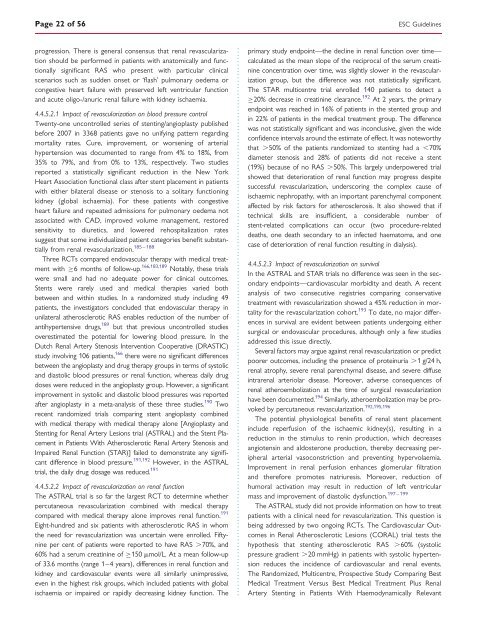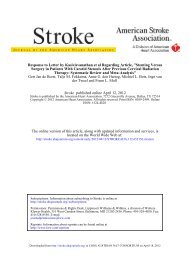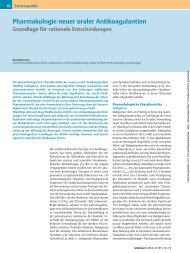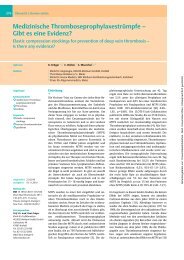ESC Guidelines on the diagnosis and treatment of peripheral artery ...
ESC Guidelines on the diagnosis and treatment of peripheral artery ...
ESC Guidelines on the diagnosis and treatment of peripheral artery ...
You also want an ePaper? Increase the reach of your titles
YUMPU automatically turns print PDFs into web optimized ePapers that Google loves.
Page 22 <strong>of</strong> 56<br />
progressi<strong>on</strong>. There is general c<strong>on</strong>sensus that renal revascularizati<strong>on</strong><br />
should be performed in patients with anatomically <strong>and</strong> functi<strong>on</strong>ally<br />
significant RAS who present with particular clinical<br />
scenarios such as sudden <strong>on</strong>set or ‘flash’ pulm<strong>on</strong>ary oedema or<br />
c<strong>on</strong>gestive heart failure with preserved left ventricular functi<strong>on</strong><br />
<strong>and</strong> acute oligo-/anuric renal failure with kidney ischaemia.<br />
4.4.5.2.1 Impact <strong>of</strong> revascularizati<strong>on</strong> <strong>on</strong> blood pressure c<strong>on</strong>trol<br />
Twenty-<strong>on</strong>e unc<strong>on</strong>trolled series <strong>of</strong> stenting/angioplasty published<br />
before 2007 in 3368 patients gave no unifying pattern regarding<br />
mortality rates. Cure, improvement, or worsening <strong>of</strong> arterial<br />
hypertensi<strong>on</strong> was documented to range from 4% to 18%, from<br />
35% to 79%, <strong>and</strong> from 0% to 13%, respectively. Two studies<br />
reported a statistically significant reducti<strong>on</strong> in <strong>the</strong> New York<br />
Heart Associati<strong>on</strong> functi<strong>on</strong>al class after stent placement in patients<br />
with ei<strong>the</strong>r bilateral disease or stenosis to a solitary functi<strong>on</strong>ing<br />
kidney (global ischaemia). For <strong>the</strong>se patients with c<strong>on</strong>gestive<br />
heart failure <strong>and</strong> repeated admissi<strong>on</strong>s for pulm<strong>on</strong>ary oedema not<br />
associated with CAD, improved volume management, restored<br />
sensitivity to diuretics, <strong>and</strong> lowered rehospitalizati<strong>on</strong> rates<br />
suggest that some individualized patient categories benefit substan-<br />
185 – 188<br />
tially from renal revascularizati<strong>on</strong>.<br />
Three RCTs compared endovascular <strong>the</strong>rapy with medical <strong>treatment</strong><br />
with ≥6 m<strong>on</strong>ths <strong>of</strong> follow-up. 166,183,189 Notably, <strong>the</strong>se trials<br />
were small <strong>and</strong> had no adequate power for clinical outcomes.<br />
Stents were rarely used <strong>and</strong> medical <strong>the</strong>rapies varied both<br />
between <strong>and</strong> within studies. In a r<strong>and</strong>omized study including 49<br />
patients, <strong>the</strong> investigators c<strong>on</strong>cluded that endovascular <strong>the</strong>rapy in<br />
unilateral a<strong>the</strong>rosclerotic RAS enables reducti<strong>on</strong> <strong>of</strong> <strong>the</strong> number <strong>of</strong><br />
antihypertensive drugs, 189 but that previous unc<strong>on</strong>trolled studies<br />
overestimated <strong>the</strong> potential for lowering blood pressure. In <strong>the</strong><br />
Dutch Renal Artery Stenosis Interventi<strong>on</strong> Cooperative (DRASTIC)<br />
study involving 106 patients, 166 <strong>the</strong>re were no significant differences<br />
between <strong>the</strong> angioplasty <strong>and</strong> drug <strong>the</strong>rapy groups in terms <strong>of</strong> systolic<br />
<strong>and</strong> diastolic blood pressures or renal functi<strong>on</strong>, whereas daily drug<br />
doses were reduced in <strong>the</strong> angioplasty group. However, a significant<br />
improvement in systolic <strong>and</strong> diastolic blood pressures was reported<br />
after angioplasty in a meta-analysis <strong>of</strong> <strong>the</strong>se three studies. 190 Two<br />
recent r<strong>and</strong>omized trials comparing stent angioplasty combined<br />
with medical <strong>the</strong>rapy with medical <strong>the</strong>rapy al<strong>on</strong>e [Angioplasty <strong>and</strong><br />
Stenting for Renal Artery Lesi<strong>on</strong>s trial (ASTRAL) <strong>and</strong> <strong>the</strong> Stent Placement<br />
in Patients With A<strong>the</strong>rosclerotic Renal Artery Stenosis <strong>and</strong><br />
Impaired Renal Functi<strong>on</strong> (STAR)] failed to dem<strong>on</strong>strate any significant<br />
difference in blood pressure. 191,192 However, in <strong>the</strong> ASTRAL<br />
trial, <strong>the</strong> daily drug dosage was reduced. 191<br />
4.4.5.2.2 Impact <strong>of</strong> revascularizati<strong>on</strong> <strong>on</strong> renal functi<strong>on</strong><br />
The ASTRAL trial is so far <strong>the</strong> largest RCT to determine whe<strong>the</strong>r<br />
percutaneous revascularizati<strong>on</strong> combined with medical <strong>the</strong>rapy<br />
compared with medical <strong>the</strong>rapy al<strong>on</strong>e improves renal functi<strong>on</strong>. 191<br />
Eight-hundred <strong>and</strong> six patients with a<strong>the</strong>rosclerotic RAS in whom<br />
<strong>the</strong> need for revascularizati<strong>on</strong> was uncertain were enrolled. Fiftynine<br />
per cent <strong>of</strong> patients were reported to have RAS .70%, <strong>and</strong><br />
60% had a serum creatinine <strong>of</strong> ≥150 mmol/L. At a mean follow-up<br />
<strong>of</strong> 33.6 m<strong>on</strong>ths (range 1–4 years), differences in renal functi<strong>on</strong> <strong>and</strong><br />
kidney <strong>and</strong> cardiovascular events were all similarly unimpressive,<br />
even in <strong>the</strong> highest risk groups, which included patients with global<br />
ischaemia or impaired or rapidly decreasing kidney functi<strong>on</strong>. The<br />
<str<strong>on</strong>g>ESC</str<strong>on</strong>g> <str<strong>on</strong>g>Guidelines</str<strong>on</strong>g><br />
primary study endpoint—<strong>the</strong> decline in renal functi<strong>on</strong> over time—<br />
calculated as <strong>the</strong> mean slope <strong>of</strong> <strong>the</strong> reciprocal <strong>of</strong> <strong>the</strong> serum creatinine<br />
c<strong>on</strong>centrati<strong>on</strong> over time, was slightly slower in <strong>the</strong> revascularizati<strong>on</strong><br />
group, but <strong>the</strong> difference was not statistically significant.<br />
The STAR multicentre trial enrolled 140 patients to detect a<br />
≥20% decrease in creatinine clearance. 192 At 2 years, <strong>the</strong> primary<br />
endpoint was reached in 16% <strong>of</strong> patients in <strong>the</strong> stented group <strong>and</strong><br />
in 22% <strong>of</strong> patients in <strong>the</strong> medical <strong>treatment</strong> group. The difference<br />
was not statistically significant <strong>and</strong> was inc<strong>on</strong>clusive, given <strong>the</strong> wide<br />
c<strong>on</strong>fidence intervals around <strong>the</strong> estimate <strong>of</strong> effect. It was noteworthy<br />
that .50% <strong>of</strong> <strong>the</strong> patients r<strong>and</strong>omized to stenting had a ,70%<br />
diameter stenosis <strong>and</strong> 28% <strong>of</strong> patients did not receive a stent<br />
(19%) because <strong>of</strong> no RAS .50%. This largely underpowered trial<br />
showed that deteriorati<strong>on</strong> <strong>of</strong> renal functi<strong>on</strong> may progress despite<br />
successful revascularizati<strong>on</strong>, underscoring <strong>the</strong> complex cause <strong>of</strong><br />
ischaemic nephropathy, with an important parenchymal comp<strong>on</strong>ent<br />
affected by risk factors for a<strong>the</strong>rosclerosis. It also showed that if<br />
technical skills are insufficient, a c<strong>on</strong>siderable number <strong>of</strong><br />
stent-related complicati<strong>on</strong>s can occur (two procedure-related<br />
deaths, <strong>on</strong>e death sec<strong>on</strong>dary to an infected haematoma, <strong>and</strong> <strong>on</strong>e<br />
case <strong>of</strong> deteriorati<strong>on</strong> <strong>of</strong> renal functi<strong>on</strong> resulting in dialysis).<br />
4.4.5.2.3 Impact <strong>of</strong> revascularizati<strong>on</strong> <strong>on</strong> survival<br />
In <strong>the</strong> ASTRAL <strong>and</strong> STAR trials no difference was seen in <strong>the</strong> sec<strong>on</strong>dary<br />
endpoints—cardiovascular morbidity <strong>and</strong> death. A recent<br />
analysis <strong>of</strong> two c<strong>on</strong>secutive registries comparing c<strong>on</strong>servative<br />
<strong>treatment</strong> with revascularizati<strong>on</strong> showed a 45% reducti<strong>on</strong> in mortality<br />
for <strong>the</strong> revascularizati<strong>on</strong> cohort. 193 To date, no major differences<br />
in survival are evident between patients undergoing ei<strong>the</strong>r<br />
surgical or endovascular procedures, although <strong>on</strong>ly a few studies<br />
addressed this issue directly.<br />
Several factors may argue against renal revascularizati<strong>on</strong> or predict<br />
poorer outcomes, including <strong>the</strong> presence <strong>of</strong> proteinuria .1 g/24 h,<br />
renal atrophy, severe renal parenchymal disease, <strong>and</strong> severe diffuse<br />
intrarenal arteriolar disease. Moreover, adverse c<strong>on</strong>sequences <strong>of</strong><br />
renal a<strong>the</strong>roembolizati<strong>on</strong> at <strong>the</strong> time <strong>of</strong> surgical revascularizati<strong>on</strong><br />
have been documented. 194 Similarly, a<strong>the</strong>roembolizati<strong>on</strong> may be provoked<br />
by percutaneous revascularizati<strong>on</strong>. 192,195,196<br />
The potential physiological benefits <strong>of</strong> renal stent placement<br />
include reperfusi<strong>on</strong> <strong>of</strong> <strong>the</strong> ischaemic kidney(s), resulting in a<br />
reducti<strong>on</strong> in <strong>the</strong> stimulus to renin producti<strong>on</strong>, which decreases<br />
angiotensin <strong>and</strong> aldoster<strong>on</strong>e producti<strong>on</strong>, <strong>the</strong>reby decreasing <strong>peripheral</strong><br />
arterial vasoc<strong>on</strong>stricti<strong>on</strong> <strong>and</strong> preventing hypervolaemia.<br />
Improvement in renal perfusi<strong>on</strong> enhances glomerular filtrati<strong>on</strong><br />
<strong>and</strong> <strong>the</strong>refore promotes natriuresis. Moreover, reducti<strong>on</strong> <strong>of</strong><br />
humoral activati<strong>on</strong> may result in reducti<strong>on</strong> <strong>of</strong> left ventricular<br />
197 – 199<br />
mass <strong>and</strong> improvement <strong>of</strong> diastolic dysfuncti<strong>on</strong>.<br />
The ASTRAL study did not provide informati<strong>on</strong> <strong>on</strong> how to treat<br />
patients with a clinical need for revascularizati<strong>on</strong>. This questi<strong>on</strong> is<br />
being addressed by two <strong>on</strong>going RCTs. The Cardiovascular Outcomes<br />
in Renal A<strong>the</strong>rosclerotic Lesi<strong>on</strong>s (CORAL) trial tests <strong>the</strong><br />
hypo<strong>the</strong>sis that stenting a<strong>the</strong>rosclerotic RAS .60% (systolic<br />
pressure gradient .20 mmHg) in patients with systolic hypertensi<strong>on</strong><br />
reduces <strong>the</strong> incidence <strong>of</strong> cardiovascular <strong>and</strong> renal events.<br />
The R<strong>and</strong>omized, Multicentre, Prospective Study Comparing Best<br />
Medical Treatment Versus Best Medical Treatment Plus Renal<br />
Artery Stenting in Patients With Haemodynamically Relevant







